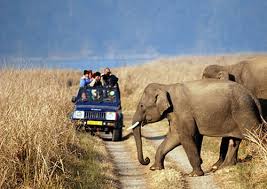There are many different Indian places to visit—each with its own sights, smells, flavors and tempos. This journey visits old colonial India, via the towns and villages built up over that period and the wildlife sanctuaries where live some of the exotic animals that India was so well known for during that time.
Two of the main animal parks in Northern India are the Jim Corbett National Park and the Binsar Wildlife Sanctuary. Both can be reached from Kathgodam, and both offer plenty of opportunities for walkers and wildlife lovers. The Binsar sanctuary covers much of the Jhandi Dhar hills, 1,800 meters above sea level, and within its borders are several rural villages which make for pleasant places to stop for supplies and sustenance, and the Corbett National Park is a home for India’s endangered Bengal Tiger, along with many other unusual plants and animals, and has a luxury tented safari camp and eco-lodge.
From Delhi you can reach Kathgodam on the Ranikhet Express which travels overnight, leaving from Old Delhi Railway Station at 10:45pm and arriving in Kathgodam at 6:05am.
Jim Corbett was a hunter who turned conservationist, who earned his early fame slaying man eating tigers and leopards that tormented the small villages of the Uttarakhand region – including the Champawat Tiger who was responsible for 436 documented deaths. His knowledge of the behaviours of the big cats, and his examinations of their corpses, lead him to theorise that most man-eaters were suffering from illnesses derived from wounds turned septic, either from gun-shots or other animals. So he didn’t really turn conservationist, he always was one, just one who took it upon himself to cull man-eaters. Corbett’s home, in Chhoti Haldwani has been turned into a museum, and is worth seeing while you’re staying in or near the park that was renamed in his honour.
The main attraction of the park are, of course, the rare tigers, but there are also 488 different plant species, and 650 different species of animal – including 37 different types of dragon fly and Indian elephants. Visitors are only allowed into some parts of the reserve, but these include spectacular riverine belts, hills leading into the Himalayas, marshlands and grasslands. As well as exploring on foot, you can also take jeep-bourne game drives, or climb aboard an elephant and get a view over the long grasses in which so many of the animals here find safety.
The wildlife sanctuary and the interesting villages in and around it, Binsar is known for its 1000 year old temple, which pilgrims from all around wore routes into the mid-altitude oak and rhododendron forests to visit. These are some of the tracks walkers can discover themselves here. Another walk worth considering is to the top of the local peak Jhandi Dhar, at the top of which you’ll get an amazing view of the Himalayan range: a 300-km wide stretch of peaks that include Kedarnath (6942 m), Chaukhamba (7140 m), Trishul (7120 m), Nanda Devi (7816 m), Nanda Not (6611 m) and Panchchuli (6904 m).
The main villages here are Kathdhara, Gonap and Satri and walking between these along the broad, cultivated terraces and in and out of the forests you’ll have the opportunity to see wild boar, deer, monkey, black bear, porcupine, mountain goat, red fox, jackal, pine marten and even leopards if you’re lucky. But part of the appeal of this place is the people themselves, who have a way of life based on old traditions of living harmoniously with this area. So it’s a cultural journey as well as an opportunity to see some incredible wildlife and scenery.
As well as these two treasures of the north, you might like to stay a while at Khali Estate while visiting Binsar. Now a secluded mountain lodge, the estate was once a colonial home before being an ashram belonging to Gandhi.
By Animesh


